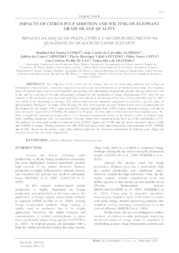Impacts of citrus pulp addition and wilting on elephant grass silage quality.
Impacts of citrus pulp addition and wilting on elephant grass silage quality.
Author(s): GOMES, R. dos S.; ALMEIDA, J. C. de C.; CARNEIRO, J. da C.; AZEVEDO, F. H. V.; LISTA, F. N.; ELYAS, A. C. W.; OLIVEIRA, T. S. de
Summary: The objective of this work was to evaluate the use of citrus pulp addition and wilting on fermentative characteristics, chemical composition as well as gas and effluent losses of elephant grass silage. The elephant grass (70 growth days) was collected manually; one portion was immediately chopped and another one was allowed to wilt in the sun for a period of 6 h and subsequently chopped for the production of silage. Experimental PVC silos (10 cm diameter x 30 cm height) were used and sand bags were placed at the bottom of the silos. Citrus pulp (80 g kg-1 of MN) was added at the beginning of ensilage. The ensiled material was manually compressed to provide a specific mass of approximately 600 kg m-3 of silage. After 60 days, the silos were opened; gas and effluent losses were calculated and we determined pH, dry matter (DM), crude protein(CP), neutral detergent fibre (NDF), lignin, ammonia nitrogen, ash and in vitro dry matter digestibility (IVDMD). We added 0 or 80 g kg-1 of citrus pulp to wilted and un-wilted elephant grass. We used a completely randomised design with a 2 x 2 factorial arrangement (wilted or un-wilted) x (with or without citrus pulp), totalling treatments with five repetitions. Average values were compared using the F test with a probability of 5%. The addition of citrus pulp resulted in reduced levels of NDF, lignin, ash, N-NH3 and pH and in increased values of DM and IVDMD of silages. Wilting increased the DM, NDF and lignin values and reduced the concentrations of CP, IVDMD and N-NH3. Based on our results, citrus pulp addition improves the chemical composition of elephant grass silage and increases its in vitro dry matter digestibility.
Publication year: 2017
Types of publication: Journal article
Unit: Embrapa Dairy Cattle
Keywords: Additive, Moisture, Pennisetum Purpureum
Observation
Some of Embrapa's publications are published as ePub files. To read them, use or download one of the following free software options to your computer or mobile device. Android: Google Play Books; IOS: iBooks; Windows and Linux: Calibre.
Access other publications
Access the Agricultural Research Database (BDPA) to consult Embrapa's full library collection and records.
Visit Embrapa Bookstore to purchase books and other publications sold by Embrapa.

